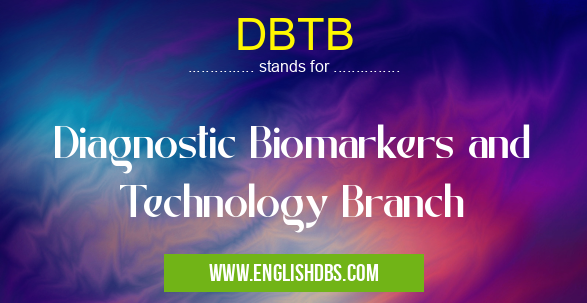What does DBTB mean in RESEARCH
Have you ever encountered the abbreviation DBTB and wonder what it stands for? DBTB stands for Diagnostic Biomarkers and Technology Branch, which is a research branch within the National Institutes of Health (NIH). The primary purpose of this branch is to support research in diagnostics and biomarkers, as well as developing new technology that can be applied to medical settings. This includes developing tests that can pre-emptively detect diseases before they become serious, thus improving patient outcomes and making health care more effective. In this article, we'll take a closer look at what DBTB means and how it impacts health care today.

DBTB meaning in Research in Academic & Science
DBTB mostly used in an acronym Research in Category Academic & Science that means Diagnostic Biomarkers and Technology Branch
Shorthand: DBTB,
Full Form: Diagnostic Biomarkers and Technology Branch
For more information of "Diagnostic Biomarkers and Technology Branch", see the section below.
Meaning of DBTB
DBTB stands for Diagnostic Biomarkers and Technology Branch, a division of the National Institutes of Health (NIH). This branch conducts research focused on developing better diagnostics, creating more accurate biomarkers, and introducing new technologies that can be used in medical settings. The primary objective of this division is to make diagnoses more reliable by developing tests that can detect diseases in their earliest stages, enabling doctors to start treatment sooner with better results. Additionally, researchers are also looking into optimizing current diagnostic protocols so that fewer people have to go through unnecessary exams or procedures.
Impact on Healthcare
The work done by the NIH’s Diagnostic Biomarkers and Technology Branch has had a profound impact on healthcare since its inception. By advancing the field of diagnostics, its goals are to reduce misdiagnoses while increasing early detection rates of potentially life-threatening diseases. This is beneficial both for patients who receive improved diagnosis times as well as healthcare providers who are able to allocate resources efficiently. Furthermore, it also enables researchers to gain insights into various disease processes which could lead to the development of new treatments for some conditions. Additionally, this work has helped advance many areas within medical science such as gene sequencing technology or artificial intelligence in radiology. All these achievements led by the NIH’s Diagnostic Biomarkers and Technology Branch demonstrate how research into modernizing technology can improve patient outcomes while reducing overall costs associated with medical treatments.
Essential Questions and Answers on Diagnostic Biomarkers and Technology Branch in "SCIENCE»RESEARCH"
What is Diagnostic Biomarkers and Technology Branch?
The Diagnostic Biomarkers and Technology Branch (DBTB) at the National Cancer Institute is responsible for developing, evaluating, and applying novel biomarkers to aid in the diagnosis of cancer. This includes research on biomarker discovery, development of tests for clinical use, policy implementation, risk assessment, and public engagement.
How does DBTB support the NCI mission?
The mission of the NCI is to reduce the burden of cancer through research to understand its biology, causes, prevention, diagnosis, treatment, survivorship and outcomes. The DBTB supports this mission by advancing our understanding of diagnostics technologies that can be used to detect cancer earlier while enabling a more precise diagnosis to inform optimal treatment options.
What are biomarkers?
Biomarkers are measurable indicators in an individual's biological sample that can provide information about their health or disease state. They are used as tools in clinical practice to improve diagnosis and inform treatment decisions allowing for more personalized medicine.
What technology does DBTB use?
DBTB employs a range of technologies such as proteomics mass spectrometry imaging with liquid chromatography coupled with tandem mass spectrometry (LC-MS/MS), single cell analysis platforms including fluorescence in situ hybridization (FISH) and flow cytometry combined with next generation sequencing (NGS). Each of these techniques provide powerful insights into the molecular mechanism underlying cancer development which can lead to better diagnostic solutions.
What type of research projects does DBTB undertake?
DBTB undertakes research projects related to many aspects associated with diagnostics such as biomarker discovery and validation studies using advanced molecular techniques; designing clinical assays for measuring biomarker levels; evaluating existing diagnostic tests in new populations; formulating recommendations on best practices for clinical utilization; implementing risk assessment protocols; and engaging stakeholders across multiple disciplines.
How do you ensure accuracy when testing for biomarkers?
To ensure accuracy when testing for biomarkers we employ rigorous quality control measures across all stages from sample collection through results interpretation including proper validation protocols based on internationally accepted standards such as CLSI and ISO 15189 guidelines. All results generated by DBTB adhere to stringent data quality requirements developed by our experts.
How do you guarantee privacy when handling patient data?
Patient privacy is a top priority at DBTB. All data is stored securely in accordance with HIPAA guidelines ensuring complete confidentiality during every step from collection through analysis. In addition all personnel involved in data handling are bound by non-disclosure agreements outlining strict accountability regarding maintaining patient privacy rights while ensuring ethical research practices.
Final Words:
In conclusion, DBTB stands for Diagnostic Biomarkers and Technology Branch at the National Institutes of Health (NIH). This branch works towards improving diagnosis accuracy while promoting early detection rates of potentially life-threatening conditions so they can be treated sooner rather than later. It focuses on advancing fields such as gene sequencing technology or artificial intelligence in radiology which helps create more efficient systems while allowing researchers to gain valuable insights into different disease types. Lastly, this work has contributed significantly towards improving patient outcomes while reducing overall healthcare costs thanks to optimized diagnostic processes.
